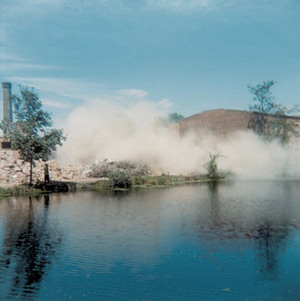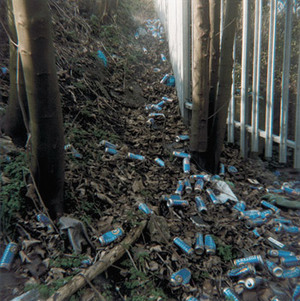January 19, 2008
They are rebuilding the city... Yes, always...
 |  |
"Perhaps you'd fancy a few miles moving through the Hackney-Stratford marshes: a complex transitional ecology of CGI imagery, doomed allotments and virtual arcadias?" So Iain Sinclair is said to have asked Robert Macfarlane before the pair set off on a tour of the areas of East London currently being 'developed' by the 2012 SF Capital megamachine. I can't help comparing Macfarlane's report of his and Sinclair's journey through the lower Lea Valley territory with the wonderful film of the construction of BBC Television Centre that Owen linked to a few weeks back.
Macfarlane and Sinclair were walking the Stalking ground of Stephen Gill, whose eerily powerful photographs provide an eerie record of the de-Zoning of the area. The theme of Gill's photographs, Macfarlane suggests, is 'the imminence of mass construction'. The film of the BBC television centre shows construction itself, soundtracked by the BBC Radiophonic Workshop. 2012 is a fatal date for Television Centre, as it is for the lower Lea valley, for it is 'by the end the financial year 2012/13' that the BBC plans to sell off the building.
BBC Television Centre is a relic of popular modernism, while the thriving improvised ecologies of the lower Lea Valley were thrown up as a side-effect of modernist development. ‘At least a third of the images in [Gill’s] Archaeology in Reverse are of plants,’ Mcfarlane tells us, ‘prospering in the foreground or seething in the background. A stand of phragmites hushes in the wind. Fields of Japanese knotweed are slashed by ODA workmen. Giant hogweed is cut, stooked and burned. Convolvulus spirals up a chain-link fence. One extraordinary photograph shows the trunk of an ash pleaching slowly round an iron railing. The tree resembles a gummy mouth, gradually eating back the metalwork.’ The lower lea Valley – London’s Tarkovsky scurf space - is full of such images: their power arises from the combination of vegetation and dereliction, the seductive lure of the overgrown. As Owen has acerbically noted, the only thing to be welcomed about the 2012 project is that, once the Capital-Spectacle has departed the glittering arcades, the wind will whistle through the dereliction of a new Zone. ‘Whatever occurs here, these images suggest, whatever is lost to this development, will only be temporary,’ Macfarlane observes. ‘Given time, the wild will reclaim the park and its structures.’
Gill’s photographs – and other similar records, in writing and on film - are the only means by which the lower Lea Valley’s unmanmade Zone can now be preserved, the march of the 2012 meganaut being as implacable as it was un-invited. Speaking of 'other records', I should note that Macfarlane's lower Lea Valley travelogue produced a very personal hauntological charge. Macfarlane and Sinclair's route - '[f]rom our first encounter with the fence, we walked widdershins: south past the Big Breakfast House, east over Stratford marsh, north up through Stratford New Town, before returning west across Hackney Marshes' - took in much of the territory that me, Heronbone, Woebot, Nick Kilroy and others used to walk in our bloggers' get-togethers. Heronbone remains perhaps the greatest poet of the lower Lea Valley, but he departed the blogosphere long ago; Woebot has just announced his online retirement, while Nick sadly died, his own photographs now constituting one of the ways in which the under-destruction lower Lea Valley is preserved.
Preserving Television Centre, meanwhile, would be a meaningless act of museumification. What mattered was a certain notion of public broadcasting - and more broadly public service - which has long since been marginalised in the 'radically reformed' BBC.
The concept of 'radical reform' perfectly captures postmodernity's tendency to pursue the same through difference. The paradox in which 'an unparalleled rate of change on all the levels of social life' goes alongside 'an unparalleled standardization of everything - feelings along with consumer goods, language along with built space - that would seem incompatible with such mutability' was the subject of Jameson's great essay 'The Antinomies of Postmodernity'. ‘The Antinomies of Postmodernity’ is at least the equal of his ‘Postmodernism and Consumer Society’ in its acute purchase on the current malaise. The temporal paradox that Jameson was coming to terms with in that essay is one that is now liable to be taken for granted, not so much analysed or lived with. Despite - or rather because of - the premium put on change and dynamism in late capitalism, Jameson argues, 'no society has ever been so standardized as this one, ... the stream of human, social and historical temporality has never flowed quite so homogenously.' This is an inversion of modernism, where 'prefabicrated modularization' gave rise to 'miraculous rebuildings', where (bog)standardization – of education, of production – produced a cultural diversity.
'Diversity' and 'choice' are of course the very names by which today’s homogeneity goes. Yet it is by now clear that it is not 'paternalistic' but consumer-driven broadcasting that leads to infantilisation, and that a proliferation of barely-rejigged formats does not constitute choice. The twinning of the Radiophonic Workshop and Television Centre perfectly illustrates that condensation of The Weird and the Public, of the aberrant and the bog-standard, that Ghost Box’s re-dreamings of public service radio idents and comprehensive school textbooks have invited us to recall. If there were a soundtrack to the BBC's selling off of Television Centre, it would be provided by Murray Gold, the composer who writes the music for the new Dr Who. Where the Radiophonic Workshop's music was atonal and anempathic, Gold’s is cloying and reassuring. You couldn't ask for a better substantiation of Adam Curtis' claim that 'television now tells you how to feel' than Gold's hysterically shrieking orchestra. The Corporation’s flagship figure, David Tennant’s beaming, emotionally incontinent Doctor, is the symbol of the de-Weirded BBC and, more broadly, of the ‘gleaming science-fictional stasis’ (Jameson) which neo-liberalism has inaugurated and administrated.
At The Weird symposium, China argued that the Weird and the hauntological stand in a relation of non-dialectical opposition. (He characterised M R James – whose work played such an important part in the BBC of the 1970s, of course – as a writer who oscillated between the two poles). Yet, repressed, suppressed and forgotten in the hyper-bright halls of the postmodern, the Weird has itself become a trace, a relic inducing hauntological yearnings. It is the Weird that haunts Ghost Box and Mordant Music’s spectral broadcasting stations.
What is important, now, is not simply a nostalgia for an earlier time, but a rescuing of what was valuable in that era from its slandering in the false memory that neo-liberalism has installed and naturalised - a task characterised by Dan on The End Times as 'reinterpreting the past in order to find a way out of the present'. From the commanding heights of the post 89 End of History, the pre-Style, pre-consumer 70s represents in time what the Soviet Union represents in space: stagnancy and shortage. Yet public funding yielded more than the dreary State propaganda or dour Reithian austerity that neo-liberalism painted as its sole products. In the December issue of Sight and Sound, Ian Christie reinforced the point I made about Tarkovsky in Marxist Supernanny:
- Tarkovsky is now generally acknowledged to be a great artist… But it is worth recalling just how much his genius owed to the limitations and freedoms of being a Soviet film maker. Back in 1981, well before the Soviet edifice began to crumble and before his own defiant departure into exile, Tarkovsky walked a tightrope between being the USSR’s highest profile director and a standing reproach to its values … Russian culture of the Soviet era was Tarkovksy’s culture, despite his contempt for its pettiness and mendacity.
(Incidentally, to correct an understandable misunderstanding created by the 'Marxist Supernanny' post, and seized upon by Ghost of a Flea, I should make it clear here that the evidence for my claim that Tarkovsky acted as an entrepreneur for Hollywood was not Soderbergh’s Solaris – which, after all, could be considered a new adaptation of Lem’s novel rather than a remake of Tarkovsky’s film – but his impact on Ridley Scott’s Alien and Blade Runner.)
Once again, the point is not to indulge in Old Left nostalgia for the Soviet state apparatus. The point is to correct the misapprehension that neo-liberalism has successfully propagated that only capitalism can produce a vibrant culture. Not only is it by now clear that the ‘dynamic’ culture of ultra-precarious capitalism would never produce something like Tarkovsky’s films, it is beginning to appear that - as Jameson suspected over a decade ago - unchallenged and unsheathed capitalism cannot produce any sort of vibrant culture at all, only endless variations on a drearily glossy theme.
(Since I've mentioned 'Marxist Supernanny': thanks to Drinked Soaked Trotskyist Popinjays who very kindly described the post as 'like Charlie Brooker with a PhD'. I can't ask for better than that!)
(Also 'Marxist Supernanny'-related: hurrah for this...)
Posted by mark at January 19, 2008 01:06 PM | TrackBack